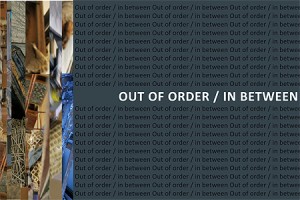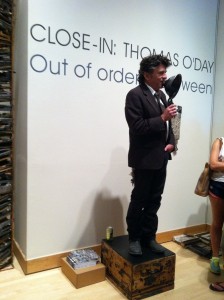It is often said, most famously by Aristotle, that art imitates life. It was during the 4th century B.C. that the Greek philosopher first developed the theory. Centuries later, however, Thomas O’Day is still adroitly employing this concept.
O’Day, a local artist and art educator, is known for producing work that, much like life, remains in a constant state of flux.
“There is nothing that remains static,” O’Day says on the Spokane Falls Community College website, “with constant change occurring day to day and minute to minute.”
O’Day’s latest exhibit, “Out of order/in-between,” has been on display at Gonzaga University’s Jundt Art Museum since July. He actually conducted a walk-through of his exhibit Thursday, discussing his work and technique with a group of about 60 people. The last day to see his installation is Friday, Aug. 31.
“I was scared when I first saw his plan for the exhibit,” said Karen Kaiser, interim director of the Jundt Art Museum. “But that changed over night. We’ve seen records numbers this summer and people have shown tremendous interest.”
The creation of the Jundt Art Museum was largely the result of Jim (’64) and Joann Jundt, who provided the lead gift for funding the construction of the building. The museum houses Gonzaga’s growing art collection and provides space for traveling and temporary exhibits, like O’Day’s installation.
O’Day, shaped by his experience as a delivery driver and installer of art for Cookes Crating in Los Angeles during the 1980s, has explored the transformation of artwork through a series of performances known as “art disposals.” He developed the idea in 1988 after running out of room in his studio.
“In the beginning, the disposal process was intended to rid the studio of unsuccessful works by completely destroying them,” O’Day said.
O’Day’s first disposal was a burial, which fittingly, even included a small funeral procession. He left the work buried for 20 years, digging it up in 2008 to see the transformations.
“It demonstrates that the past stays with us,” O’Day said during the walk-through, “but it constantly changes. It never stays the same.”
Besides burials, disposals can also include, among other things, burning, freezing, chemical contamination, shredding or explosions. For one such disposal, in fact, O’Day used fertilizer and about 50 gallons of gasoline to create a rather substantial explosion.
“That one scared us a bit,” he joked.
Following each disposal, O’Day then gradually incorporates the remains of the destroyed works into new work and it ultimately ends up having “little to do with art as an object.”
“It is about work whose final outcome is in constant flux,” O’Day said. “The commitment to making this work reflects the reality of our own changing lives. What we are left with is the experience and memories of each episode of our lives.”
O’Day holds a bachelor’s degree from California State University, Long Beach and a master’s degree from CSU, Northridge. He moved to Spokane in 1985 and a year later began teaching as an adjunct professor at Spokane Falls Community College and the Spokane Art School. In 1998, he was hired at SFCC as a full time instructor and gallery director.
In addition to Spokane, O’Day’s work has been featured in galleries throughout the West, including Los Angeles and Seattle. He has also traveled extensively, visiting places in Europe, England, Ireland, Greece, Mexico, Tahiti and Canada.
So it seems O’Day’s life, much like his work, is anything but static.

